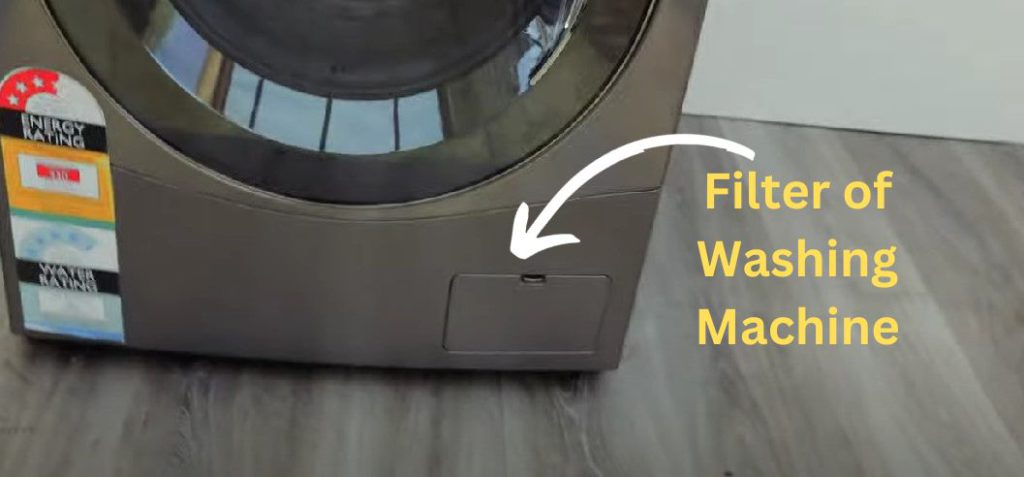LG washing machine not draining issues can be resolved by troubleshooting the drain hose and pump. In some cases, clogs or obstructions in the drain hose can cause water not to drain properly, while a faulty pump may require replacement to fix the problem.
Dealing with a washing machine that won’t drain properly can be frustrating and time-consuming. If you own an LG washing machine and are facing drainage issues, there are a few steps you can take to troubleshoot and resolve the problem.
By addressing potential blockages in the drain hose and checking for pump malfunctions, you can restore your washing machine’s draining functionality. We will explore the common reasons behind LG washing machine draining problems and provide you with effective solutions to get your laundry routine back on track. So, let’s dive in and find out how to tackle this issue head-on.
Step 1: Checking the Filter

The first line of defense against the OE error is the filter. It’s crucial to inspect it regularly, ideally every six months, depending on your usage. The filter is typically located on the bottom right-hand corner of your machine. Follow these steps:
- Identify the filter compartment.
- Open it using your hands; no tools are required.
- Remove any debris or lint accumulated in the filter.
- Clean the rubber seal around the filter to prevent leaks.
Pro tip: Keep a towel handy, as water may spill during this process.
Step 2: Investigating Deeper

If the OE error persists, a more in-depth investigation is needed. Grab a flashlight or use your smartphone to illuminate the interior. Follow these steps:
- Examine the pump area for any visible obstructions.
- Check the hole near the corner for foreign objects hindering the pump’s operation.
- If necessary, manually clear any debris from the pump area.
- Inspect the drain pump seal; ensure it’s clean to prevent leaks.
Step 3: Removing the Bottom Panel
To gain better access to the pump, you’ll need to remove the bottom panel of your LG washing machine. Here’s how:
- Use a flat-head screwdriver to pry the panel gently from the clips.
- Remove any screws securing the panel in place.
- Once removed, set the panel aside, exposing the pump.
Step 4: Accessing the Drain Pump
With the bottom panel removed, you can now focus on the drain pump. Follow these steps:
- Locate the main board that is obstructing access to the pump.
- Remove the screws securing the main board.
- Carefully detach the board, creating more room to reach the pump.
Step 5: Replacing the Drain Pump
If the OE error persists, you may need to replace the drain pump. Here’s a brief overview:
- Disconnect the power to the pump by removing the brown and black wires.
- Remove the screws securing the pump in a triangular formation.
- Carefully pull the pump out, extending the cable if necessary.
- Replace the pump with a suitable replacement.
- Reconnect the power and secure the pump in place.
More Here: LG WASHING MACHINE FLASHING
Tips For Optimizing Drainage Efficiency
Optimizing drainage efficiency is essential in ensuring your LG washing machine functions properly. Regular cleaning and maintenance are key factors in maintaining optimal drainage. Cleaning the drain pump filter regularly helps eliminate blockages and build-up that can hinder drainage. Similarly, checking drain hoses for any obstructions or kinks will ensure smooth water flow.
Using the right detergents and fabric softeners is also crucial for efficient drainage. Avoid using excessive amounts of detergent and softener, as this can lead to excessive sudsing and clogging of the drainage system. Follow the manufacturer’s guidelines for the correct amount of detergent to use for each load and choose low-sudsing options.
Loading and distributing the laundry properly can also contribute to better drainage. Avoid overloading the machine, as excess clothes can obstruct water flow and affect drainage. Distribute the laundry evenly in the drum to prevent unbalanced loads, which can disrupt drainage cycles.
Components Of The Drainage System
Modern LG washing machines are equipped with advanced drainage systems to efficiently remove water from the machine after each wash. The drainage system consists of several components, including the drain pump, drain filter, and drain hoses with connections.
The drain pump plays a crucial role in expelling the water from the tub. It is responsible for creating the necessary pressure to pump the water out of the machine. Regular maintenance and cleaning of the drain pump is essential to ensure its optimal performance.
The drain filter prevents lint, debris, and other objects from entering the drainage system and potentially causing blockages. It is recommended to clean the drain filter periodically to maintain proper drainage and prevent clogging.
The drain hoses and connections are responsible for channeling the water from the washer to the external drainage point. It is important to check these hoses and connections for any damage or leaks to prevent water leakage and ensure efficient drainage.
| Component | Description |
|---|---|
| Drain Pump | The pump is responsible for removing water from the machine. |
| Drain Filter | Filters out lint, debris, and other objects to prevent clogging. |
| Drain Hoses and Connections | Channel the water from the washer to the external drainage point. |
Understanding The Drainage Process
Understanding the Drainage Process
The drainage process in an LG washing machine consists of three key cycles: the intake and washing cycle, the rinse and spin cycle, and the final drain and spin cycle.
| Intake and Washing Cycle | The first cycle begins when the machine fills with water, allowing the detergent to dissolve and mix with the clothes. The agitator then works to clean the clothes by rotating them in every direction. This cycle sets the foundation for the rest of the washing process. |
| Rinse and Spin Cycle | After the initial washing, the machine moves on to the rinse and spin cycle. In this cycle, the washer drains the dirty water and refills the tub with clean water for rinsing purposes. It then spins the clothes at high speeds to remove excess water, leaving them ready for the final phase of drainage. |
| Final Drain and Spin Cycle | The last cycle focuses on draining all remaining water from the machine. The washer removes the water through a drain pump and then spins the clothes one last time to extract any excess moisture. This ensures that the clothes are left as dry as possible and ready for the next step, which could be drying or simply being hung up to air dry. |
This understanding of the drainage process in an LG washing machine allows users to better comprehend and troubleshoot any issues with draining that may arise during their laundry chores.
Common Drainage System Malfunctions
In a washing machine, the drainage system plays a crucial role in ensuring efficient and smooth operations. However, like any other appliance, problems can arise with the drainage system, leading to subpar performance. One common issue is a faulty drain pump motor, which can result in inadequate draining. The pump motor is responsible for pumping out the water from the tub, and if it malfunctions, the water may not drain properly.
Another potential problem is a clogged drain filter. Over time, lint, debris, and other particles can accumulate in the filter, obstructing the water flow and preventing proper drainage. Regularly cleaning and maintaining the drain filter can help prevent this issue.
Additionally, leaking or damaged drain hoses can also cause drainage problems. Hoses may develop cracks or become loose, leading to water leakage and ineffective draining. Inspecting hoses for any signs of damage and replacing them if necessary can help resolve this problem.
| Common Drainage System Malfunctions |
|---|
| Faulty Drain Pump Motor |
| Clogged Drain Filter |
| Leaking or Damaged Drain Hoses |
Consulting Lg Washing Machine Manuals And Guides
In order to properly drain your LG washing machine, it is important to consult the manufacturer’s manuals and guides. These materials provide valuable information and instructions specific to your machine model.
Understanding the manufacturer’s guidelines ensures that you follow the recommended steps for draining the machine efficiently and effectively. These guidelines often include step-by-step instructions and diagrams to help you navigate through the process. Make sure to read them thoroughly before starting.
If you encounter any issues, troubleshooting tips and tricks can be incredibly helpful. These tips provide insights into common problems and offer solutions to resolve them. They often highlight potential causes and symptoms to guide your troubleshooting efforts.
By consulting the LG washing machine manuals and guides, understanding the manufacturer’s guidelines, and utilizing troubleshooting tips and tricks, you can ensure that your washing machine drains properly, allowing for optimal performance and longevity.
Frequently Asked Questions For Lg Washing Machine Draining
How Do I Fix A Clogged Drain In My Lg Washing Machine?
To fix a clogged drain in your LG washing machine, start by removing any visible debris from the drain pump filter. Then, use a pipe cleaner to clear any blockages in the drain hose. If the issue persists, contact a professional technician for assistance.
Why Is My Lg Washing Machine Not Draining Water?
If your LG washing machine is not draining water, it could be due to a clogged drain hose or a malfunctioning drain pump. Check the drain hose for any obstructions and clean it if necessary. If the problem continues, it may be best to consult a technician for further inspection and repair.
How Often Should I Clean The Drain Filter In My Lg Washing Machine?
It is recommended to clean the drain filter in your LG washing machine every few months or as needed. Regular maintenance of the drain filter helps prevent clogs and ensures optimal performance of your washing machine. Refer to the manufacturer’s instructions for specific guidance on cleaning and maintenance.
Conclusion
Maintaining a well-functioning LG washing machine drainage system is crucial for optimal performance and longevity. By regularly cleaning the filter, checking for clogs, and ensuring proper installation, you can avoid common drainage issues. It’s also important to address any leaks or unusual noises promptly to prevent further damage.
Following these simple steps will keep your LG washing machine running smoothly and ensure clean and efficiently drained laundry.

